API 数据源
当用户使用 EXT API 数据时,可以通过 API 数据源将数据接入到衡石系统。 API 数据源定义统一的数据接入规范,能支持大量的无数据计算能力的 API 数据源。内置多种 API 数据源的同时支持用户自定义开发方式加入企业内部 API 数据源或其他公有 API 数据源,快速读取 API 数据源。API 数据源轻松实现接入外部 API 数据由1到 N 的快速增长,增强衡石数据的整合能力。
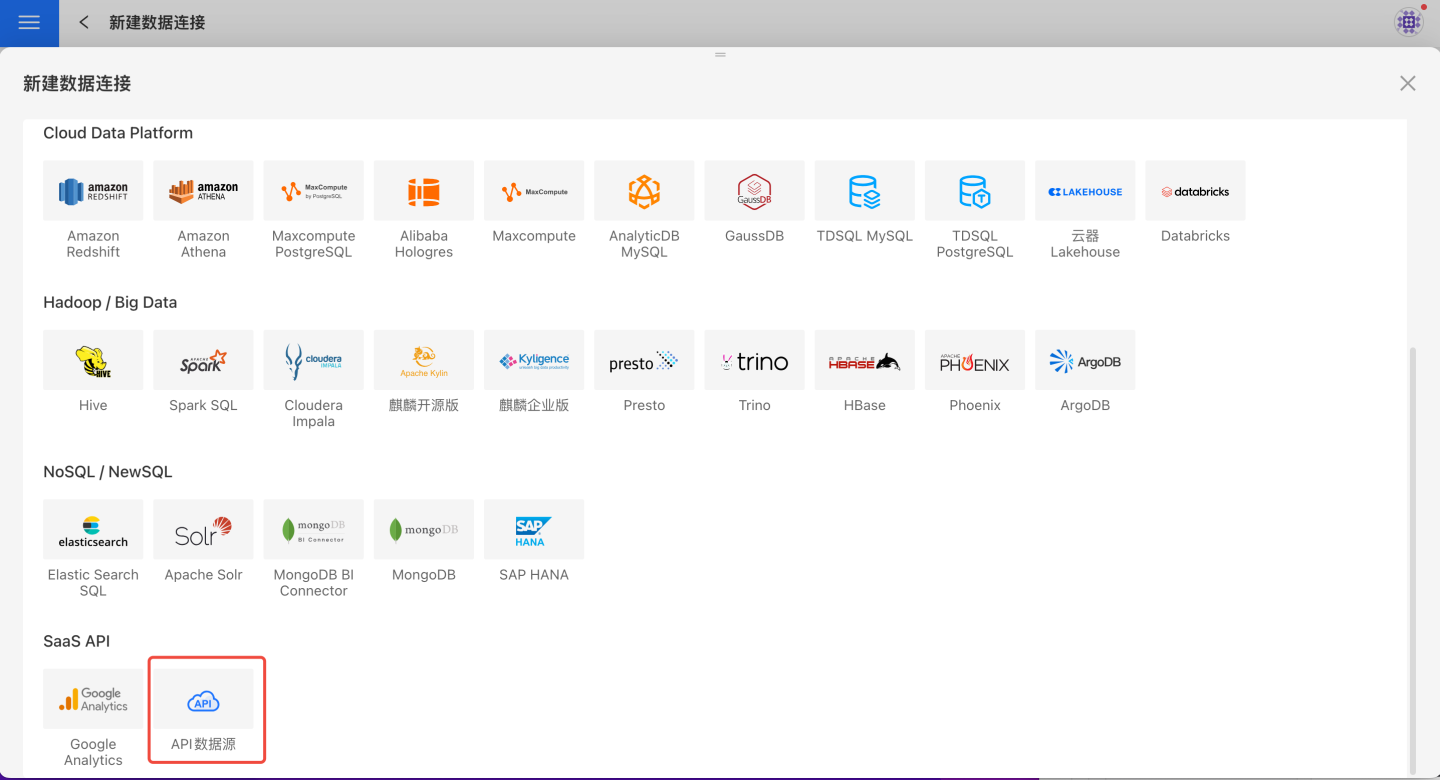
内置 API 数据源
明道云数据源
用户在明道云上的应用数据通过简单的配置就可以连接到衡石系统。配置步骤如下:
在新建数据连接中选择 API 数据源。

输入新建连接名称,API name 选择
mingdaoyun。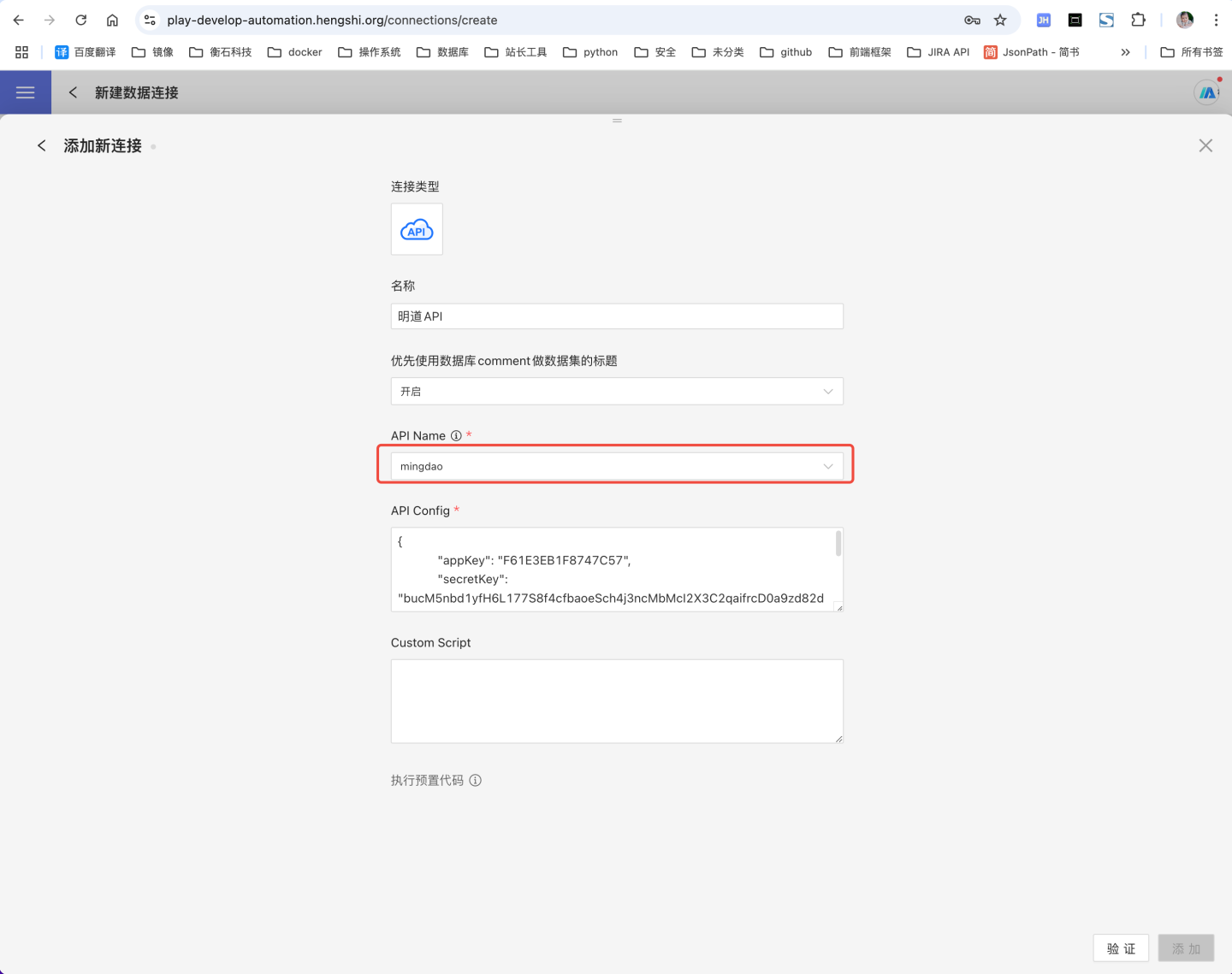
填写明道云配置信息 API Config,示例如下:
json{ "appKey":"ab1axxxxxxxx", "secretKey":"68b7eqbp7r1p5ZeAbw60aXcG0h8Gxxxxxxxxxxxxxxxxxxxxxxxxxxxxxxxxxxxxxxxxxxxxx", "sign":"NWRiODkxZmQ0NzljNzcxZDhiMDZjMzE5ZDxxxxxxxxxxxxxxxxxxxxxxxxxxxxxxxxxxxxxxxxxxxxxxx", "apiUrl": "https://api.mingdao.com/v2/open" }明道云 API Config 配置说明
字段 是否必填 取值说明 appKey 是 明道云应用中的 AppKey secretKey 是 明道云应用中的 secretKey sign 是 明道云应用中的 sign apiUrl 否 明道云为私有部署时,apiUrl 请填写私有部署地址;公有部署时 apiUrl 可置空或填写明道云公有地址 验证成功后,点击保存,数据连接创建完成。在系统中可以查看和使用明道云中的数据。
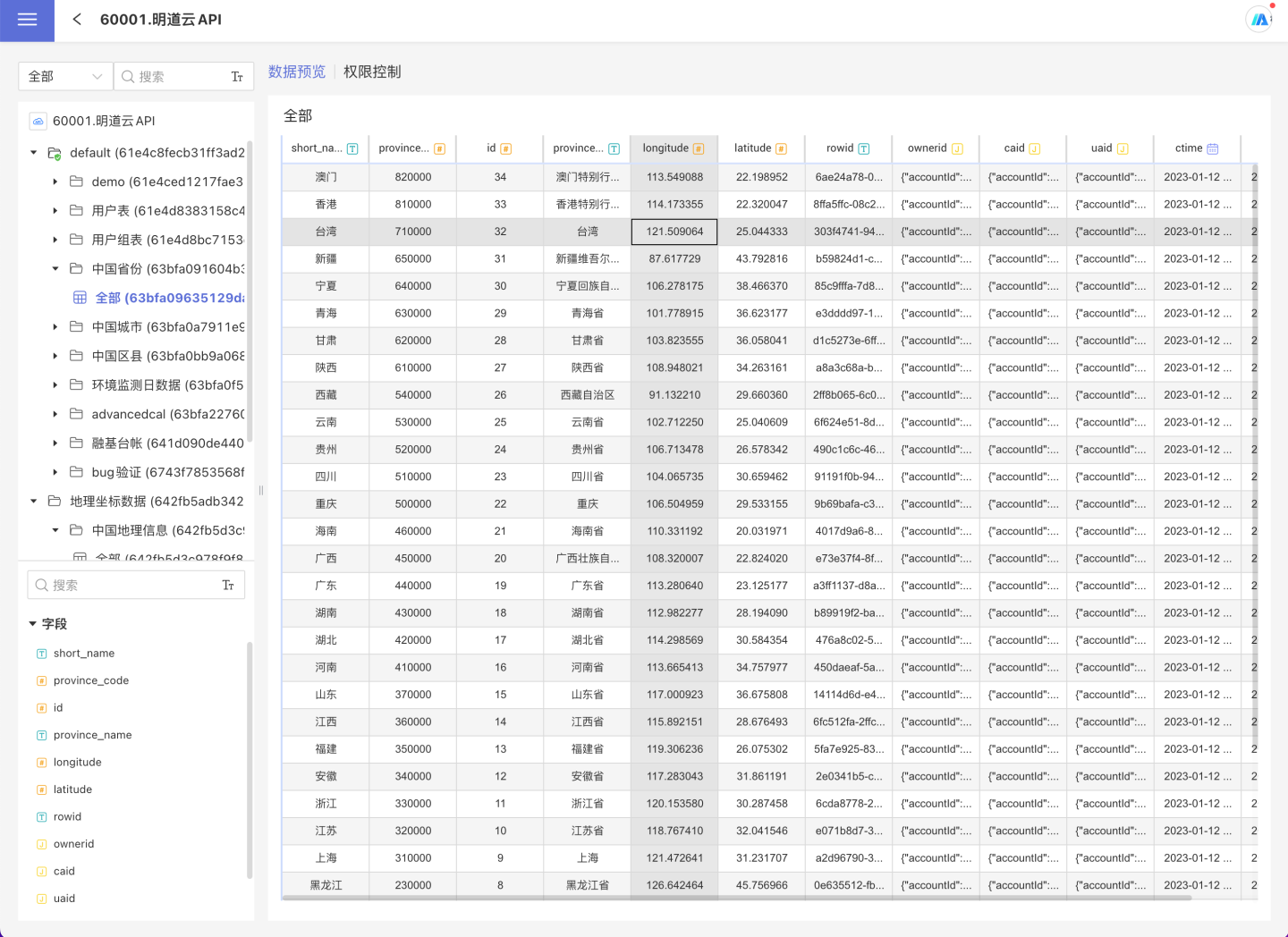
FTP 数据源
系统支持 FTP 数据源,在 HENGSHI SENSE 中通过简单配置,可以读取 ftp 指定路径下的文件。 配置步骤如下。
在新建数据连接中选择 API 数据源。

输入新建连接名称、,API name 选择
ftp填写FTP的 API Config配置信息,示例如下:
json{ "host":"10.10.x.y", "username":"xxxxxxx", "password":"xxxxxxx", "directory":"/opt/ftp", "encoding":"utf8", "passive":true, }FTP数据源的 API Config 配置说明
字段 是否必填 取值说明 host 是 ftp服务器的地址 username 是 ftp登录名 password 是 ftp登录密码 directory 否 ftp映射目录 encoding 否 编码 passive 否 验证成功后,点击保存,数据连接创建完成。在系统中可以查看和使用连接数据。
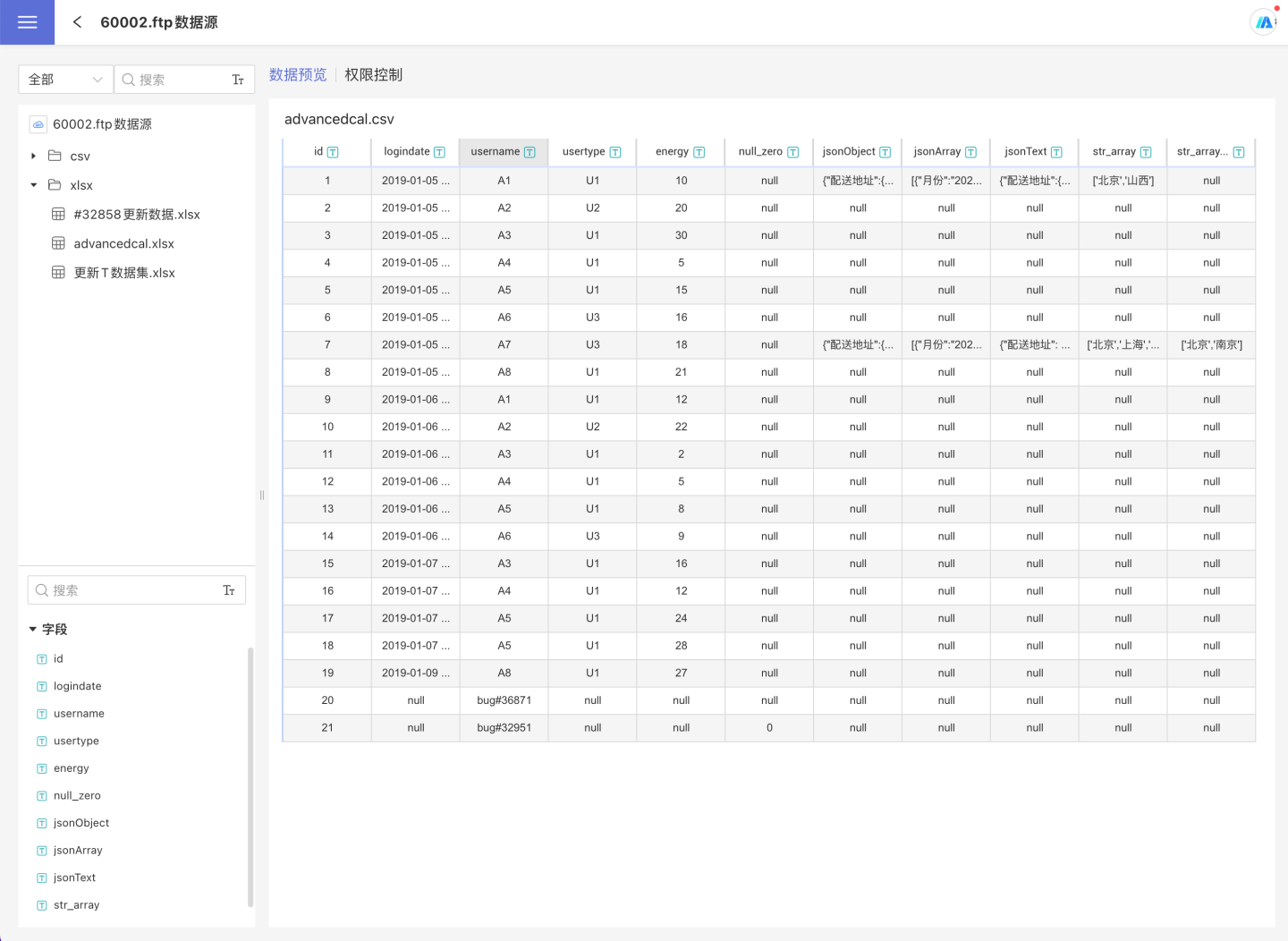
提示
FTP 数据源只能将 csv 和 excel 解析为表的形式,其他类型的文件不支持解析。
FTP数据源中, excel格式的只能在新建数据集后预览数据,不支持直接在 数据连接 中预览。
其他内置数据源
除了上述 FTP 和明道云外,系统还支持 S3、旺店通、企业微信、石墨文档、聚水潭、易仓科技、Wai Qin等 API 数据源,用户配置 API config 后,即可将数据接入到衡石系统中。
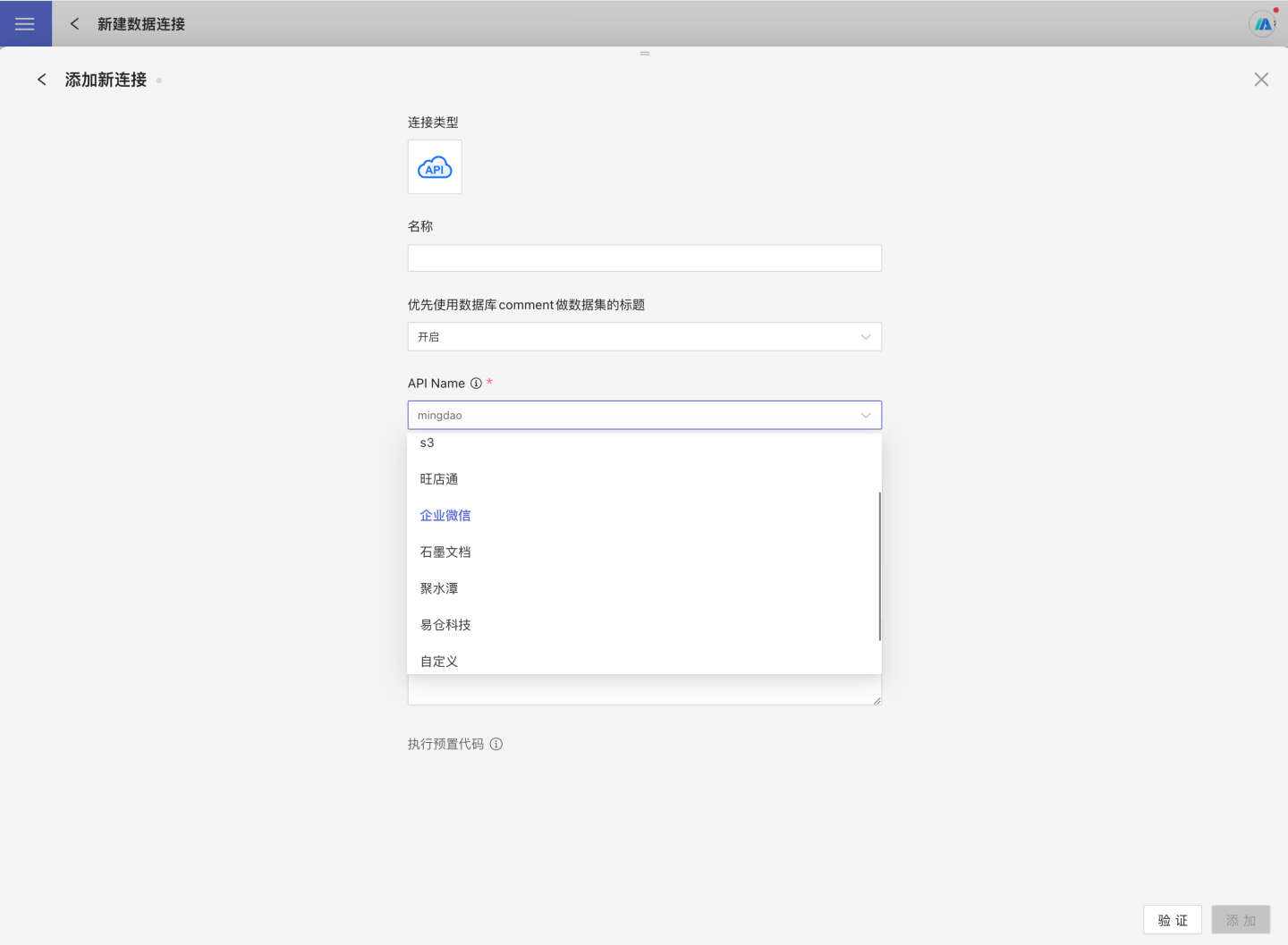
API Config配置示例
下面是支持的几个内置API数据源的 API Config的配置示例:
S3数据源的API Config
{
"access_key_id": "AKIAWBC5HCDHELXXXXXXXX",
"secret_key_id": "67U4ZvclZxkqiM9owAVTEootwyxxxxxxxx",
"region": "cn-north-x",
"useVirtualFolderDelimiter": false,
"bucket": "",
"path": ""
}旺店通 数据源的API Config
{
"appsecret": "3a5737fc6bc2d6970f790308xxxxxxxx",
"sid": "xxxxxxxx",
"appkey": "xxxxxxxx-ot",
"env": "production",
"customizedStartTime": "2022-01-01 00:00:00",
"addHSTimeColumn": true,
"tableConfig": {
"/stockin_order_query.php": {
"timeWindow": 60,
"timeWindowLimit": 50
}
}
}企业微信 数据源的API Config
{
"corpid": "wwcXXXXXXXXXX",
"corpsecret": "XGGBxxxxxxxxxxxxxxxxxxxxxxxx",
"customizedStartTime": "2022-09-01 00:00:00",
"addHSTimeColumn": false,
"templates": [
"ZLyhvnbAYmJnwLXyyxxxxxxxxxxxxxxxxxxxx1",
"ZLyhvnbAYmJnwLXyyxxxxxxxxxxxxxxxxxxxx2"
]
}石墨 数据源的API Config
{
"sid": "s%3A7db3e9d7bab34969a6d592xxxxxxxxxxxx.hnmK3aq2yOYYJB9exxxxxxx",
"addHSTimeColumn": true,
"customCacheMaxLifetime": 5
}聚水潭 数据源的API Config
{
"app_key": "b0b7d1db226d4216xxxxxxxxxxxxxxxx",
"app_secret": "99c4cef262f34ca88xxxxxxxxxxxx",
"access_token": "b7e3b1e24e174593xxxxxxxxxxx",
"env": "test",
"customizedStartTime": "2022-11-15 00:00:00",
"addHSTimeColumn": true,
"tableConfig": {
"/open/orders/single/query": {
"timeWindow": 30,
"timeWindowLimit": 3
}
}
}易仓科技 数据源的API Config
{
"app_key": "e4bd91dcxxxxxxxx",
"service_id": "xxxxxxxx",
"secret_key": "bab4d5xxxxxxxx"
}Wai Qin 数据源的API Config
{
"openId": "76776371xxxxxxxx",
"appKey": "u7To2bdLxxxxxxxx",
"customFormList": [
"74842108646xxxxxxxx1",
"74842108646xxxxxxxx2"
],
"aiProductIdentificationResultQueryStartTime": "2025-01-01 00:00:00"
}自定义 API 数据源
除了内置的 API 数据源外,系统支持用户自定义 API 数据源,可以使用groovy脚本实现自定义 API 数据源。
- 在新建数据连接中选择 API 数据源。

- 输入新建连接名称、,API name 选择
自定义 - 填写 API Config配置信息,注意: 这里的 配置信息需要在脚本中通过代码解析。不需要配置时,建议填空
{} - 按照规范编写自定义 API 数据源的 Groovy 脚本,放到
Custom Script

自定义API 数据源脚本规范
自定义数据源接入时,需要在 Groovy 脚本中实现下面四个接口。
- getAPIName : 用来获取 API 名称。
- setOptions:用来处理认证鉴权相关配置信息。
- fetchPathTables:用户获取数据源目录结构。
- fetchTableData : 用于获取 table 节点数据。
函数 getAPIName
函数 getAPIName 的作用是输出 API 名称。 每一个 API 数据源名称不能相同,如果相同会导致发生冲突。 该函数是类 static 函数,返回值为 string 类型的字符串。
static getApiName() {
return "TrivalApiDemo"
}函数 setOptions
函数 setOptions 的作用是用来保存处理认证鉴权相关的配置信息。 如果不涉及外部网络请求,可以直接留空了。 该函数是 object 函数, 函数参数是一个 JSON 字符串,这个字符串是用户在添加数据连接时填写的信息。
def setOptions(String options) {
if (!options?.trim()) {
return
}
def json = jsonSlurper.parseText(options)
if (json.cityCodeURL?.trim()) {
config.cityCodeURL = JSON.cityCodeURL
}
if (json.weatherURL?.trim()) {
config.weatherURL = JSON.weatherURL
}
}函数 getPathTables
函数 getPathTables 的作用是返回目录树,把该数据源的所有 catalog/schema/table 的结构都返回。 代码示例如下。
def getPathTables() {
def tableTree = [
[ pathType: "table", name: "table1", tableType: "table"],
[ pathType: "path", name: "schema2",
children: [
[ pathType: "table", name: "table3", tableType: "view"],
[ pathType: "table", name: "table4", tableType: "table", remarks: "表别名4"]
]
]
]
return new JsonBuilder(tableTree).toString()
}结构定义说明:
- pathType 的种类有 table(代表叶子结点的表), path(代表数据库中的 schema 或者 catalog)
- name 就是 表名或者 schema/catalog 的名字
- tableType 只对 table 有意义,它的类型一般写成 table 就可以了(另外一个选项是 view,不常用)
- 当 pathType 为 path 时,代表这个节点不是一个表,而是一个 schema 或者 catalog 这样的中间目录结构,此时它可以有 children 数组节点
- remarks 是当前节点的一个说明,需要的时候可以提供,是可选项。
通过上面的函数定义的 schema, 可以在数据连接中获取 table。
函数 fetchTableData
函数 fetchTableData 函数的作用是获取一个叶子节点,即 table 节点的数据。代码示例如下。
def fetchTableData(List<String> tablePath) {
def tableName = tablePath.last()
def schemaData = [
schema: [
[fieldName: "field1", label: "字段别名1", type: "string"],
[fieldName: "field2", label: null, type: "string"],
[fieldName: "field3", type: "number"],
[fieldName: "field4", type: "date"],
[fieldName: "field5", type: "time"]],
data: [
["a", "b", 10, "2022-01-01", "2022-01-01 23:59:59"],
["c", "d", 20.20, "2019-12-39", "2019-12-39 23:59:59"]
]
]
return new JsonBuilder(schemaData).toString()
}Schema 结构定义:
- fieldName 字段名,需要在 table 内具有唯一性,能区分不同的字段。
- type:字段的类型,常用的类型有:string, number, date, time, json, bool。
- label:字段的别名。
Data 结构定义:
- data 的每一个元素都是一个数组,数组的元素个数必须和 schema 相同,数据的类型也必须一一匹配。
自定义API 数据源代码示例
下面使用 Java 构造一个天气 API 自定义数据源。weather.groovy 文件定义内容如下:
//Weather.groovy
import com.hengshi.nangaparbat.dto.DatasetResultDto
import com.hengshi.nangaparbat.model.PathTableNode
import static com.hengshi.nangaparbat.model.Dataset.Field
import static com.hengshi.nangaparbat.model.Type.TypeName
import groovy.json.JsonSlurper
class Provider {
static getApiName() {
return "天气 API"
}
def setOptions(String options) {
if (!options?.trim()) {
return
}
def json = jsonSlurper.parseText(options)
if (json.cityCodeURL?.trim()) {
config.cityCodeURL = json.cityCodeURL
}
if (json.weatherURL?.trim()) {
config.weatherURL = json.weatherURL
}
}
def getPathTables() {
def txt = config.cityCodeURL.toURL().text
def arr = jsonSlurper.parseText(txt)
return arr.collect{ obj ->
def node = PathTableNode.createTableNode(obj.city_code)
node.setRemarks(obj.city_name)
return node
}
}
def fetchTableData(List<String> tablePath) {
def url = config.weatherURL + tablePath.last()
def txt = url.toURL().text;
def result = new DatasetResultDto()
def schema = []
def data = []
def row = []
def arr = jsonSlurper.parseText(txt)
arr.data.each{ k, v ->
def field = new Field();
field.setFieldName(k)
field.setType(TypeName.string)
if (k.startsWith("pm")) {
field.setType(TypeName.integer)
}
schema.add(field)
row.add(v);
}
result.setSchema(schema)
data.add(row)
result.setData(data)
return result
}
def jsonSlurper = new JsonSlurper()
def config = [
cityCodeURL: "https://github.com/baichengzhou/weather.api/raw/master/src/main/resources/citycode-2019-08-23.json",
weatherURL: "http://t.weather.itboy.net/api/weather/city/"
]
}代码说明:
- DatasetResultDto 定义了 fetchTableData 的返回结果,它由 schema 和 data 组成,通过 setData 和 setSchema 来写入。
- PathTableNode 定义了 getPathTables 的返回,它由 pathType, name, children 和 tableType 组成,也是通过各自的 setter 来写入
- schema 由多个 Field 组成,Field 由 fieldName, type 和 label 组成。
- type 的种类是一个枚举类型定义的 TypeName。
- CityCode中定义了目录结构。
- 天气网站是天气数据来源,记录了各个城市的天气数据。